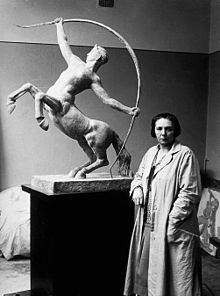Sigrid Fridman
Sigrid Fridman | |
|---|---|
 | |
| Born | Sigrid Carolina Sofia Fridman 23 November 1879 Haparanda, Sweden |
| Died | 8 January 1963 (aged 83) Stockholm, Sweden |
| Nationality | Swedish |
| Occupation | sculptor |
| Years active | 1911–1963 |
| Known for | Centaur, sculpture at Observatorielunden in Stockholm |
Sigrid Carolina Sofia Fridman (23 November 1879 – 8 January 1963) was a Swedish sculptor most known for her works of women and the Centaur sculpture which is located in the park known as Observatorielunden in Stockholm. Many of her sculptures are located in public parks throughout the country.
Early life
Sigrid Carolina Sofia Fridman was born on 23 November 1879 in the Haparanda Municipality of Norrbotten County, Sweden to Mathilda Kristina (née Bruhn) and Karl Gustaf Fridman. She attended Arvedson's Gymnastics Institute (sv), in Stockholm,[1] a school designed in 1902 to teach women the skills of physiotherapy.[2]
Career
Moving to London after her graduation, Fridman began working as a physical therapist.[1] As a hobby, she began studying sculpting in a private studio around 1911.[3][4] In 1912, she moved to Paris to focus on her art and enrolled at the Académie de la Grande Chaumière, under the tutelage of Antoine Bourdelle. After studying in Paris for four years, in 1916, she exhibited in the London Spring Exhibition of the Grosvenor Gallery.[4] From around 1914, Fridman was involved in a relationship with the artist Ragnhild Barkman.[5][6]
Fridman returned to Sweden and settled in Gothenburg, producing a series of decorative works. She was commissioned by the Swedish seafaring company Atlantica in 1921 to create two statues for their new building. She produced Sea Horse (Swedish: Havshästen) and Walrus (Swedish: Valrossen), both in black granite. In the same period, she sculpted another piece of black granite known as Penguin's Well (Swedish: Pingvinbrunnen), which is now located on the grounds of the Swedish Museum of Natural History. Other known pieces from her Göteborg period include Fauns (Swedish: Faunerna), Skipping youth (Swedish: Hukande yngling) and a bust of Torgny Segerstedt.[1]

Around 1924, Fridman and Barkman moved to Stockholm and became friends with another lesbian couple, Klara Johanson and Ellen Kleman.[5][6] They spent time together until Johanson's death in 1948, often taking summer trips together to Rättvik and Masesgården.[7] On one study trip to Greece, Fridman and Johanson became romantically involved, though neither left their long-term partners.[6] In 1927, Fridman created a sculpture of Fredrika Bremer,[8] which caused controversy about whether a woman should be engaged as a serious sculptor. This debate continued, with many male colleagues taking the position that women should only sculpt children's portraits or small pieces that depicted femininity, when in 1928, Fridman proposed her Centaur statue.[3]
Fridman's work Centaur became her most noted piece. Completed in 1939, angry controversy surrounded it as well, with many complaining that the figure was not culturally sensitive, as centaurs were not part of the national folklore.[3] The statue, in bronze is unadorned and reflects the power of the creature in its strong composition.[1] Though initially Fridman intended the sculpture to be displayed at the beginning of Library Street, it was installed on the hill near the observatory in Observatorielunden in Stockholm. In 1948, Johanson published a book in defense of Fridman and other women artists, Sigrid Fridman—och andra konstnärer: en krigskrönika (Sigrid Fridman—and other artists: a war chronicle).[3]
Fridman's statue of Ellen Key (1953) was also the subject of fierce debate, and as the artist aged, she became more introverted, though she continued to work. Various pieces of her sculpture are scattered throughout the country in public spaces, such as variant centaurs in Örebro and Bollnäs, a figure of Pan with pipes in Härlanda and a fountain in the garden of Villa Muramaris near Visby in Gotland. Her last work, Det droppande trädet (The Dripping Tree) is located in Odengatan near the City Library and was installed the year after her death.[3]
Death and legacy
Fridman died on 8 January 1963 in Stockholm County, Sweden.[1]
Gallery
- Örebro centaur
- Muramaris Fountain
- Fredrika Bremer
- Ellen Key
- The Dripping Tree
References
Citations
- ^ a b c d e Karlsson 1966, p. 512.
- ^ Yttergren & Bolling 2016, p. 197.
- ^ a b c d e Sällskapet Nya Idun 2016.
- ^ a b University of Glasgow 2011.
- ^ a b Burman 2015, p. 285.
- ^ a b c Larsson 2007.
- ^ Burman 2015, pp. 342–343.
- ^ Burman 2015, p. 296.
Bibliography
- Burman, Carina (2015). K.J.: En biografi över Klara Johanson (in Swedish). Stockholm, Sweden: Albert Bonniers Förlag. ISBN 978-91-0-014970-3.
- Karlsson, Gunilla (1966). "Sigrid CS Fridman". Riksarkivets (in Swedish). Svenskt biografiskt lexikon. Archived from the original on 25 February 2017. Retrieved 23 October 2017.
- Larsson, Maria Bergom (3 June 2007). "Klara och passionen" [Klara and passion]. Aftonbladet (in Swedish). Stockholm, Sweden. Archived from the original on 23 October 2017. Retrieved 23 October 2017.
- Yttergren, Leif; Bolling, Hans (2016). "Kvinnor, karriär och familj: En studie av svenska kvinnliga gymnastikdirektörers yrkeskarriärer och livsöden kring sekelskiftet 1900" [Women, Career and Family: A Study of Swedish Women's Gymnastics Professional Careers and life death around the turn of the century, 1900]. Historisk Tidskrift (in Swedish). 136 (2). Stockholm, Sweden: Svenska Historiska Foreningen: 185–219. ISSN 0345-469X. Retrieved 23 October 2017.
- "Sigrid Fridman". Sällskapet Nya Idun (in Swedish). Stockholm, Sweden: The New Idun Society. 2016. Archived from the original on 20 December 2016. Retrieved 23 October 2017.
- "Sigrid Fridman". University of Glasgow. Glasgow, Scotland: Mapping the Practice and Profession of Sculpture in Britain and Ireland 1851-1951. 2011. Archived from the original on 4 March 2015. Retrieved 23 October 2017.





